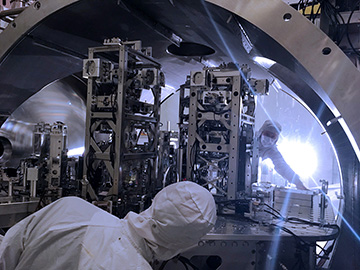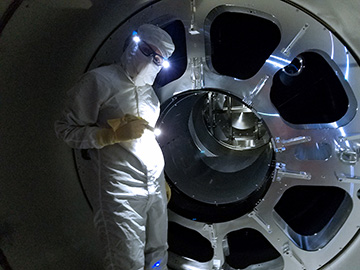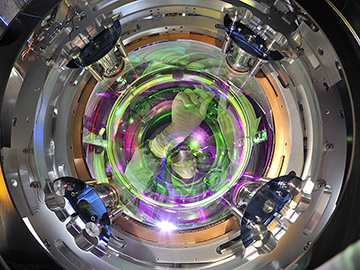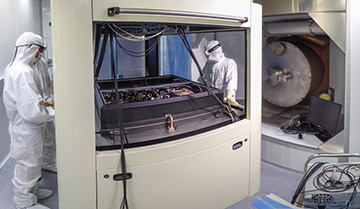Engineers Hugh Radkins and Betsy Weaver at work inside the vacuum system of the detector at LIGO Hanford Observatory, Washington, USA, during recent harware upgrades. With the upgrades complete, the two U.S. LIGO facilities, in partnership with the Virgo facility in Italy, are now poised to begin third observation run. [Image: LIGO/Caltech/MIT/Jeff Kissel] [Enlarge image]
1 April 2019—A bit more than three years after the first, landmark detection of gravitational waves (GWs), the LIGO and Virgo laser interferometer GW observatories today kick off their third observation run.
Known in the GW community simply as “O3,” the year-long observation run will likely yield a bumper crop of new astronomical observations—the result of a 40 percent improvement in the already jaw-dropping sensitivity of the two LIGO facilities in the United States and a near-doubling of the sensitivity of the Virgo facility in Italy. The O3 period also could see the long-awaited on-streaming of the KAGRA GW observatory in Japan. And, in a new twist, the LIGO/Virgo Scientific Collaboration (LSC) will be making data about possible GW detections publicly available in near real time.
Boosting laser power
The O3 run will add to the impressive string of milestones achieved in the first two GW observation runs. These include the detection of gravitational waves from ten binary black-hole mergers, as well as from the collision of a pair of ultra-dense neutron stars. The latter detection—coordinated with observations from more traditional optical, X-ray and gamma-ray telescopes in a path-breaking example of “multi-messenger astronomy”—resulted in a breathtaking harvest of new scientific information.
LIGO team member Alena Ananyeva at the LIGO Livingston Observatory, installing “baffles” to control stray light. [Image: LIGO/Caltech/MIT/Matt Heintze] [Enlarge image]
LSC scientists are confident that the LIGO and Virgo observatories will log observations at an even faster clip in O3, as a result of technical improvements implemented since the end of the last observation run, O2, in August 2017 (see “Gravitational Waves: The Next Step,” OPN, May 2018).
The improvements include a doubling of the power of the facilities’ lasers, which in these observatories are amplified in two Fabry–Pérot cavities 3 to 4 km long that form the arms of a gigantic, L-shaped Michelson-interferometer. Also installed in the upgrade round were scattered-light suppressors, or “baffles,” designed to control stray light within the huge interferometers.
Hammering down noise
In addition to laser power, other recent upgrades have centered on efforts to boost sensitivity by ferreting out and eliminating noise sources in a range of subsystems.
At LIGO, this has included the huge engineering challenge of swapping out a number of the 40-kg mirrors, or test masses, exquisitely suspended at either end of the laser interferometer arms. As a passing gravitational wave ripples through spacetime, tiny movements in these hefty mirrors result in infinitesimal changes of the interferometer arms’ lengths, which are read as picowatt-scale power fluctuations at the dark port of the interferometer. The new, better-performing versions of the mirrors include improved coatings to diminish thermal noise.
A view of one of the Virgo mirrors, or test masses, from behind, as a researcher removes the safety stops from the mirror after the recent upgrade. (The mirror is reflective in the infrared range used by the Virgo interferometer, but transparent to visible light.) [Image: EGO/Virgo Collaboration/Perciballi] [Enlarge image]
At Virgo, meanwhile, the steel wires suspending the main mirrors have been replaced with fused-silica versions that quiet down vibrational noise and extend the facility’s ability to pick up low- and medium-frequency GWs. And during O3, both LIGO and Virgo will use a trick of quantum mechanics, the injection of a “squeezed” state of light at the photodetector, to narrow down the uncertainties in photon arrival times attributable to fluctuations in the quantum vacuum.
These and other technical improvements were partly developed and matured at yet another facility, GEO 600, a smaller GW observatory in Europe that has served as a vital testbed for technologies to sharpen the observing power of the larger sites. GEO 600 will also participate in the O3 run.
Sampling more of the cosmos
Researchers install the squeezed-light source in a cleanroom at the Virgo gravitational-wave detector. [Image: © H. Lück/B. Knispel/Max Planck Institute for Gravitational Physics] [Enlarge image]
The recent sensitivity upgrades will enable the global GW network to sample a much-expanded slice of the cosmos for evidence of high-energy astronomical events. In the O3 run, for example, LIGO’s sensitivity in the wake of the recent upgrades should enable it to sniff out binary neutron-star mergers to a distance of 550 million light-years—more than 190 million light-years further than in O2.
That, coupled with an eightfold expansion of the volume of space now visible to Virgo, could increase the rate of detection of binary black-hole collisions to anywhere from a few events per month to a few per week, and binary neutron-star mergers to between one per year and one per month. There’s also the possibility of picking up more exotic, previously inaccessible events, such as the merger of a black hole and a neutron star.
Instant access to data
In another change, the public will have near-immediate access to this harvest of discoveries, through new software developed by LSC scientists. The software will be “able to send open public alerts within five minutes” after a GW detection, according to Sarah Antier, a postdoctoral research associate at the Université Paris Diderot, France.
That will allow rapid public access to parameters such as type of signal, sky position and estimated distance for a given GW event. Those parameters, in turn, will let both professional and amateur astronomers looking at various slices of the electromagnetic spectrum quickly train their instruments on the right patch of sky to follow up on the GW observation.
KAGRA on the way?
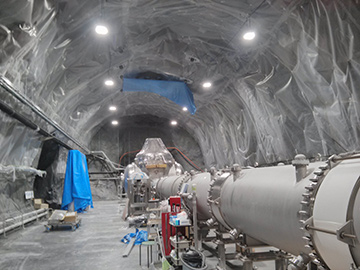
A portion of one of the KAGRA interferometer arms, under construction in 2015. [Wikimedia Commons/Christopher Berry]
The ability to locate GW sources quickly and precisely could receive yet another boost late in the year-long O3 period, with the long-awaited debut of KAGRA. An underground 3-km laser-interferometer GW observatory whose design includes suspended sapphire test masses cryogenically cooled to 20 K, KAGRA has been under construction in Japan since 2010. But its development has been plagued by ongoing difficulty in banishing vibrational noise attributable to cryo-cooling equipment and even to water infiltration in the underground facility.
In January of this year, however, the KAGRA team finally reported a successful 10-day test of the interferometer at cryogenic temperatures. With that significant milestone behind it, the team is optimistic that the facility will be able to make its first scientific observations in late 2019.

